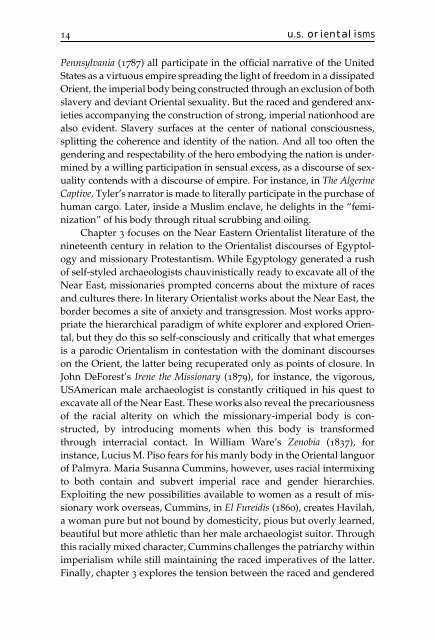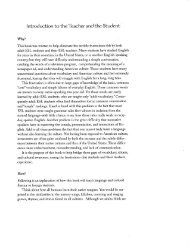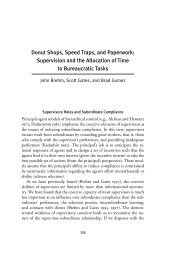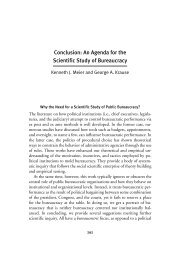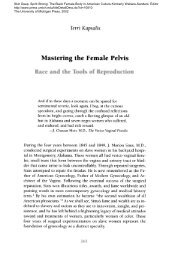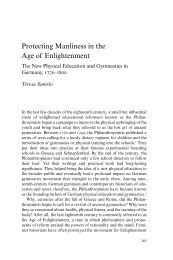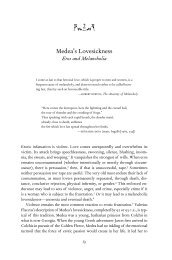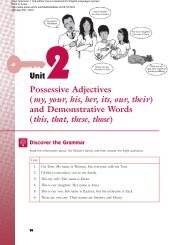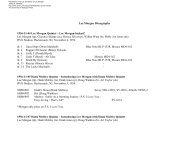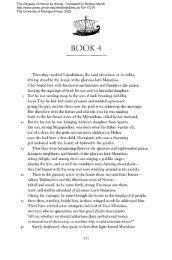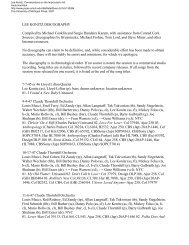Introduction - The University of Michigan Press
Introduction - The University of Michigan Press
Introduction - The University of Michigan Press
You also want an ePaper? Increase the reach of your titles
YUMPU automatically turns print PDFs into web optimized ePapers that Google loves.
14 u.s. orientalisms<br />
Pennsylvania (1787) all participate in the <strong>of</strong>ficial narrative <strong>of</strong> the United<br />
States as a virtuous empire spreading the light <strong>of</strong> freedom in a dissipated<br />
Orient, the imperial body being constructed through an exclusion <strong>of</strong> both<br />
slavery and deviant Oriental sexuality. But the raced and gendered anxieties<br />
accompanying the construction <strong>of</strong> strong, imperial nationhood are<br />
also evident. Slavery surfaces at the center <strong>of</strong> national consciousness,<br />
splitting the coherence and identity <strong>of</strong> the nation. And all too <strong>of</strong>ten the<br />
gendering and respectability <strong>of</strong> the hero embodying the nation is undermined<br />
by a willing participation in sensual excess, as a discourse <strong>of</strong> sexuality<br />
contends with a discourse <strong>of</strong> empire. For instance, in <strong>The</strong> Algerine<br />
Captive, Tyler’s narrator is made to literally participate in the purchase <strong>of</strong><br />
human cargo. Later, inside a Muslim enclave, he delights in the “feminization”<br />
<strong>of</strong> his body through ritual scrubbing and oiling.<br />
Chapter 3 focuses on the Near Eastern Orientalist literature <strong>of</strong> the<br />
nineteenth century in relation to the Orientalist discourses <strong>of</strong> Egyptology<br />
and missionary Protestantism. While Egyptology generated a rush<br />
<strong>of</strong> self-styled archaeologists chauvinistically ready to excavate all <strong>of</strong> the<br />
Near East, missionaries prompted concerns about the mixture <strong>of</strong> races<br />
and cultures there. In literary Orientalist works about the Near East, the<br />
border becomes a site <strong>of</strong> anxiety and transgression. Most works appropriate<br />
the hierarchical paradigm <strong>of</strong> white explorer and explored Oriental,<br />
but they do this so self-consciously and critically that what emerges<br />
is a parodic Orientalism in contestation with the dominant discourses<br />
on the Orient, the latter being recuperated only as points <strong>of</strong> closure. In<br />
John DeForest’s Irene the Missionary (1879), for instance, the vigorous,<br />
USAmerican male archaeologist is constantly critiqued in his quest to<br />
excavate all <strong>of</strong> the Near East. <strong>The</strong>se works also reveal the precariousness<br />
<strong>of</strong> the racial alterity on which the missionary-imperial body is constructed,<br />
by introducing moments when this body is transformed<br />
through interracial contact. In William Ware’s Zenobia (1837), for<br />
instance, Lucius M. Piso fears for his manly body in the Oriental languor<br />
<strong>of</strong> Palmyra. Maria Susanna Cummins, however, uses racial intermixing<br />
to both contain and subvert imperial race and gender hierarchies.<br />
Exploiting the new possibilities available to women as a result <strong>of</strong> missionary<br />
work overseas, Cummins, in El Fureidis (1860), creates Havilah,<br />
a woman pure but not bound by domesticity, pious but overly learned,<br />
beautiful but more athletic than her male archaeologist suitor. Through<br />
this racially mixed character, Cummins challenges the patriarchy within<br />
imperialism while still maintaining the raced imperatives <strong>of</strong> the latter.<br />
Finally, chapter 3 explores the tension between the raced and gendered


